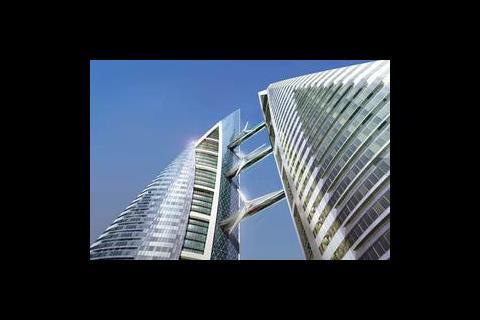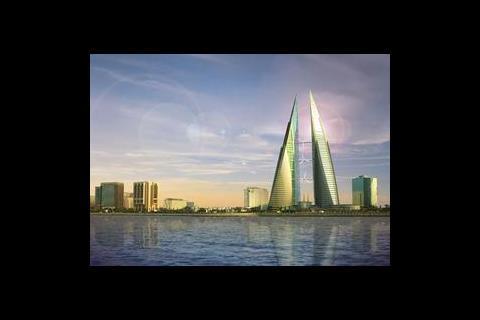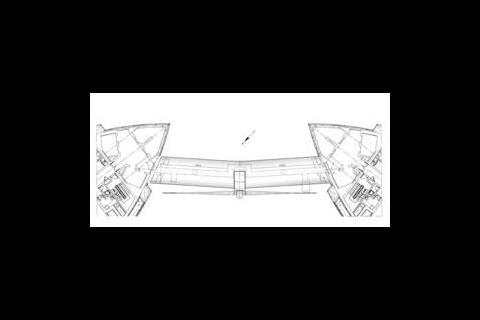Until recently, the integration of large-scale wind turbines was a great idea, but far too expensive to put into practice. Stephen Kennett reveals how the Bahrain World Trade Center has changed all that with its intuitive use of facade engineering
Here’s this month’s starter for ten: where is the world’s largest shopping centre under construction? Its tallest building? Biggest theme park? First underwater hotel? That’s right, they’re all in the Middle East, where the sheer number and size of construction products under way is breathtaking. And now, the region can add the world’s first building to feature integrated, large-scale horizontal axis wind turbines to its rather impressive list.
The Bahrain World Trade Center, due for completion in 2006, is an ambitious project. When it came to the design of this 50-storey building – the focal point of a scheme to rejuvenate an existing hotel and shopping mall – Atkins, the architects and consulting engineers, wanted to exploit its location.
The Trade Center site overlooks the Arabian Gulf and benefits from the unobstructed prevailing on-shore breeze off the water; Atkins is harnessing this to provide a renewable source of energy for the development.
According to Shaun Killa, the architect in charge of the scheme, the client bought into the design from the concept stage – however, the programme was extremely tight, a situation further compounded by the need to carry out a major R&D programme.
Atkins had looked at the concept of integrated turbines on previous schemes, but its studies highlighted the reason they don’t get built – excessive costs (up to 30% of the project value), resulting mainly from adaptations to the building design and the high development costs for special turbines.
“We avoided this on the Bahrain World Trade Center by using conventional technology and building design,” reveals Richard Smith, associate director of technology at Atkins. The team designed a building that would be sympathetic to the integration of wind turbines. “The premium for achieving this was around 3% of the project’s value,” says Smith.
By European standards, the Trade Center is large. Two 50-storey towers sit on top of a three-storey podium and basement, which accommodate a new shopping centre, restaurants, business centre and car parking.
Why sustainability is a breeze
The entire complex is designed to maximise the energy that can be captured from the sea breeze. The two office towers are turned to face the prevailing wind and taper up to a height of 240 m. Their elliptical plan and sail-like profiles act as aerofoils, funnelling the onshore breeze between them while creating a negative pressure behind that accelerates the wind. The vertical tapering reduces the aerofoil section of the towers and has the effect, when combined with the increasing velocity of the onshore breeze at height, of creating near-identical wind speed at the three turbines between the towers.
The three turbines are predicted to generate between 1100 MWh and 1300 MWh per year: 11-15% of the total electricity consumption of the two office towers
The shape and arrangement of the towers was crucial to maximise the power that could be generated, while also reducing fatigue on the turbine blades. Wind tunnel testing was followed up with CFD analysis to confirm how the buildings sculpt the airflow.
The wind is deflected by the towers to create an airstream that passes between the two buildings at an angle well within the skew tolerance of the turbines. Calculations show that the turbines will be able to operate for winds up to 45° from the turbine axis, but turbine predictions and initial operating regimes are based on a more cautious range of 30° from the axis. At wind directions outside this range, the turbine will automatically adopt a standstill mode.
Another benefit of the tower’s funnelling effect is that it amplifies the wind speed at turbine height by around 30%. This amplification, in conjunction with the shape of the towers (larger effect at ground) and the velocity profile of the wind (lowest at ground) balances the energy yield to the extent that the upper and lower turbines will produce 109% and 93% respectively, compared to a value of 100% for the middle turbine.
The other challenge for the design team was to support the 11-tonne turbines. The bridges span 32 m between the towers and are complex structures incorporating maintenance-free bearings where they join the buildings, allowing the towers to move by half a metre relative to one another. In plan, they form a shallow “V” to accommodate blade deflection during extreme operating conditions – a maximum clearance of 1.12 m – and a laser monitoring system will stop the turbine if deflections become excessive.
The bridges are designed to withstand and absorb wind-induced vibrations and those brought about by both operating and stationary turbines. The design team analysed the natural frequency of the bridge to make sure it didn’t coincide with the frequency of its exciting vibrations or that of the building and cause it to shake itself apart. If, during commissioning, vibrations are found to be a problem, spoilers can be added to the bridge and the tuned mass damper can be adjusted.
The three turbines are predicted to generate between 1100 MWh and 1300 MWh per year, approximately 11–15% of the electricity consumption of the two office towers. This breaks down as 340–400 MWh/year for the lower turbine, 360–430 MWh/year for the middle turbine and 400–470 MWh/year for the top turbine. These are conservative figures. “We have erred on the side of caution in our predictions,” says Killa. “Since this is a world first and because wind turbines have not yet been placed 160 m above ground level and between buildings, the yield may be even higher.”
In a region where developers are constantly vying to build the biggest and most outlandish schemes, this could just be the beginning for large-scale integrated wind turbines.
Steps taken to reduce energy use
The Bahrain World Trade Center is not intended to be a low carbon emissions building by European and other worldwide standards. However, compared to other Middle East developments, it does include a number of design solutions aimed at reducing energy use:
- Buffer spaces between the external environment and air-conditioned spaces – for example the car park deck above and towards the southern end of the mall – will have the effect of reducing solar air temperature and conductive solar gain
- A significant proportion of projectile shading to the external glass facades
- Low leakage, openable windows that allow mixed mode operation in winter months
- Variable volume chilled water pumping that will operate with significantly less pump power at part loads than constant volume pumping
- Thermal wheels used to recover coolth from the exhaust air
- Dual drainage systems that segregate foul and waste water and allow grey water recycling to be added at a later date
- Connection to the district cooling system. This will enable a large improvement on carbon emissions since in Bahrain, water-cooled chillers are not allowed due to water shortages – the district cooling solution will involve sea water cooling/heat rejection
- Deep gravel roofs provide additional insulation – the heat of the sun creates an updraught in the gravel layer limiting conduction.
Wind turbines: the facts and figures
Although vertical axis turbines offer the advantage of being omni-directional and thus able to make use of wind coming from any direction, the development of large-scale versions for building applications was still unproven at the design stage of the Bahrain World Trade Center. Instead, the design team opted for horizontal wind turbines. For practical reasons, these are fixed rather than pole-mounted – which would allow them to turn and face the direction of the wind. The drawback of this is that they can only operate with wind from a limited azimuth range to avoid problems with blade deflections and stressing through excessive skew.
Source
Building Sustainable Design


























No comments yet